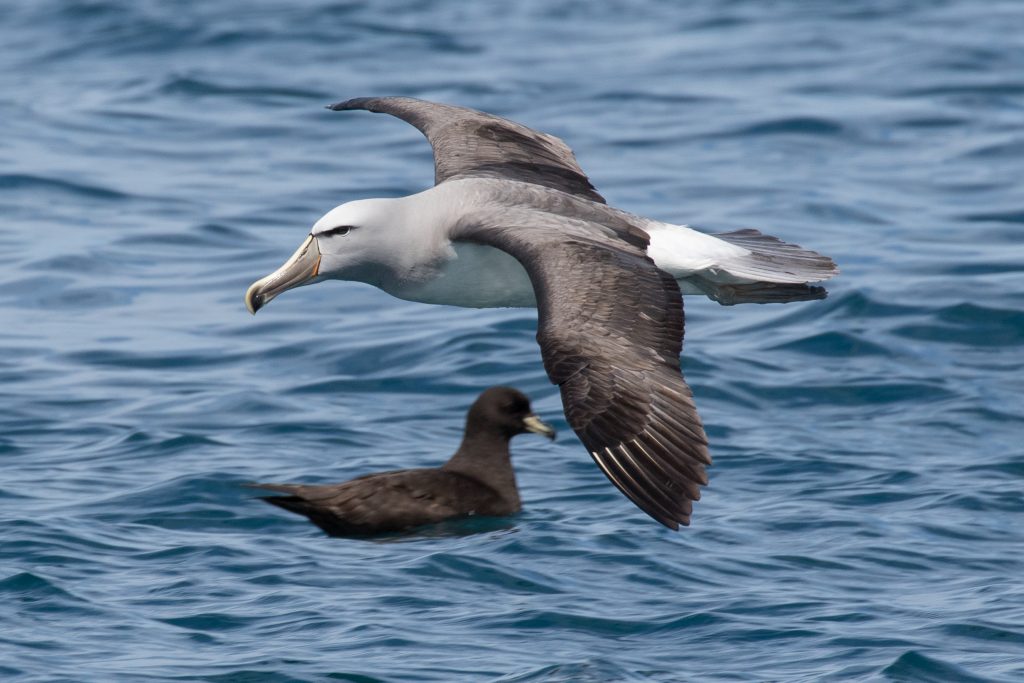My favourite photo: David Brooks, Salvin’s albatross

Photo by David Brooks, Salvin’s albatross, Kaikoura
I wouldn’t say this is necessarily my favourite bird photo but I’ll never forget the day I took it. I was on seabird sightseeing trip off Kaikoura, one of the best places in New Zealand to get close to the albatrosses, petrels and other seabirds usually inaccessible to landlubbers like me.
The sky was brilliantly blue and the sea smooth as a pond as we headed out to sea, the snow-capped Kaikōura mountains receding behind us. Occasional sightings of pods of Dusky dolphins or lone fur seals indicated why Kaikōura is famous as a hotspot for marine life.
The skipper obviously knew where to go to find the birds or perhaps more importantly where they could find us. After a couple of albatrosses appeared nearby he stopped the boat and attached a net filled with fish scraps and waste to the back of the boat.
It didn’t take long to have the desired effect. First came small brown and white Cape petrels, followed by the first of the Salvin’s albatrosses, Westland and white-chinned petrels, white-capped albatrosses, and vicious looking giant petrels.
Last to the party were the northern royal albatrosses, circling the boat in ever tightening circles before gliding into land nearby. Royal by name and regal by nature, the big birds showed no fear, calmly pulling food from the netting just a metre or two from our clicking cameras and excited chatter. The more obsessive birdwatchers who seem fixated by ticking off names off their avian wish list seem a little strange to me. Having said that, it was a thrill for me to see around 10 bird species I had never encountered before, especially close up.
The Salvin’s albatross, which is part of the grouping of smaller albatrosses known as mollymawks, lacks the size and awe-inspiring wingspan of the northern royal and wandering albatrosses. But it certainly is a glamorous bird in an understated way with its light grey head, yellow to grey beak with dark tip, dark grey upper wing and mostly white underneath. The black around the upper sides of the eye adds a dash of mystery and threat.
As well as a lack of fear, the birds around our boat shared a complete mastery of the air, gliding serenely just above the surface of the sea. They were so close that their wing tips would often slash a line on the surface as they banked into a turn.
The only time the albatrosses appeared to be making any effort at all was when they took off, the slow flapping of their massive wings accompanied by the frantic pumping of their legs as they lumbered into the air.
But the scavenging of fish scraps at the back of the boat by at least two dozen birds was a troubling reminder of how vulnerable these birds are to being injured or killed by baited fish hooks, nets and other fishing gear, especially when fish waste is discarded from fishing boats.
No doubt many fishers admire these magnificent seabirds too but it is vital they use all the available ways of cutting and eventually eliminating seabird bycatch. Good rules and strong enforcement are what we need to ensure New Zealand does the right thing by these beautiful birds. These rules should be in line with international best practice and cameras or observers should be on all boats to make sure those rules are being followed.
Salvin’s albatrosses are listed as critical in the New Zealand threat classification and are among the top five seabirds caught as fishing bycatch in New Zealand waters. It’s depressing to think that preventable bycatch deaths are contributing to the decline of these birds.
I’m sure if more New Zealanders took the opportunity to get close to our seabirds, the pressure for better protection would only grow.
By David Brooks. David has been both a staff member, magazine contributor and contract writer for Forest & Bird for many years. He was inspired to develop his nature photography skills through walking through Zealandia in Wellington.
You can sign Forest & Bird’s Zero ByCatch pledge here. Forest & Bird are calling for more protection for our albatross, other seabirds and marine life.

